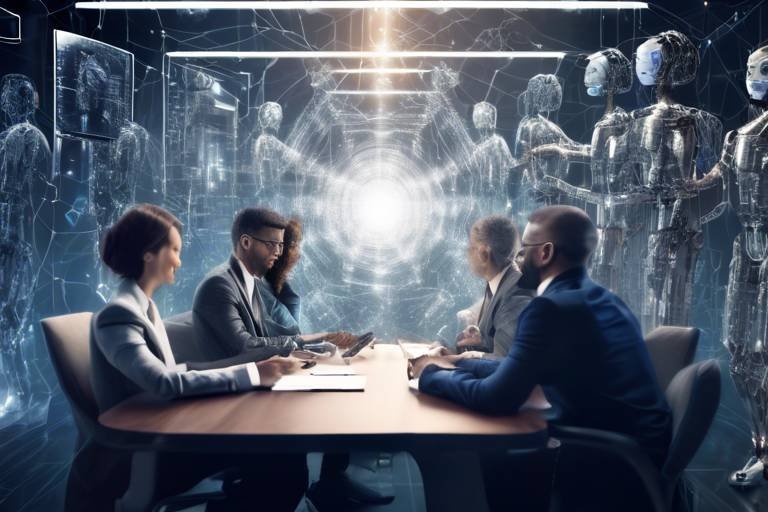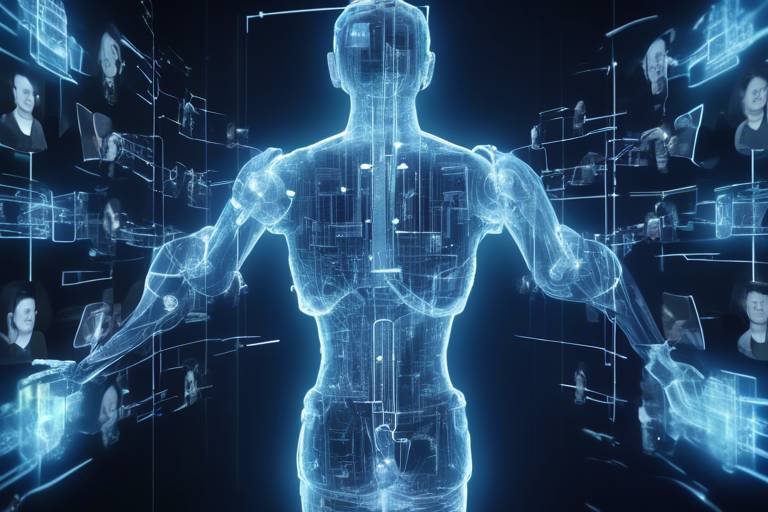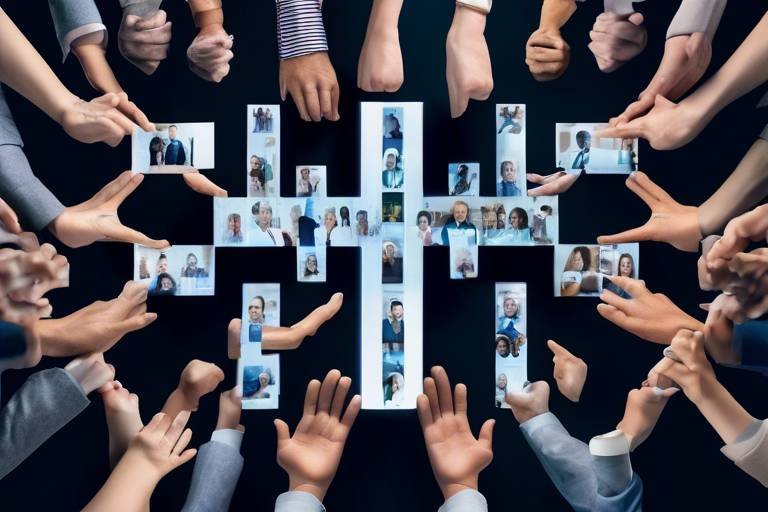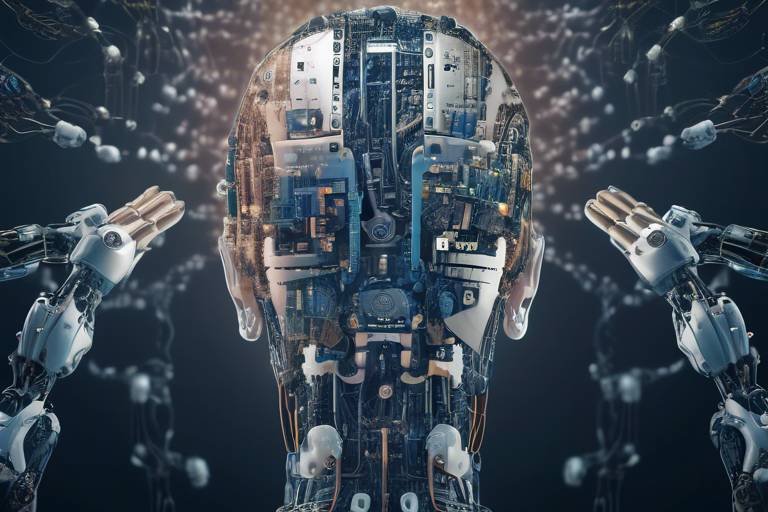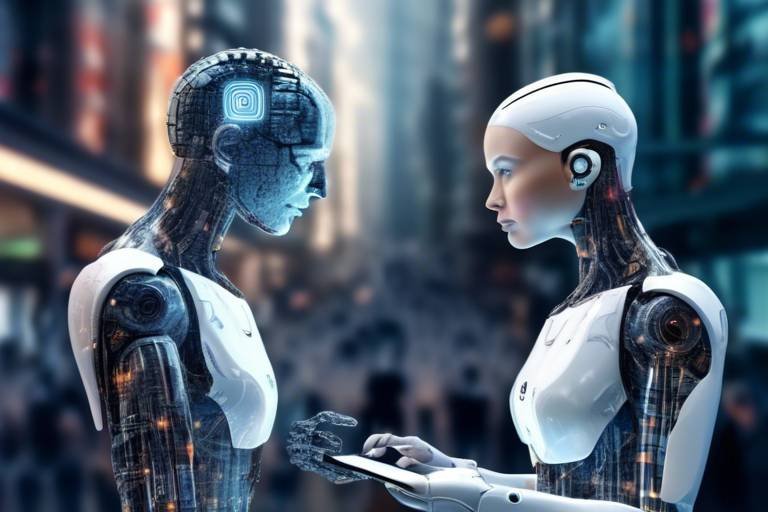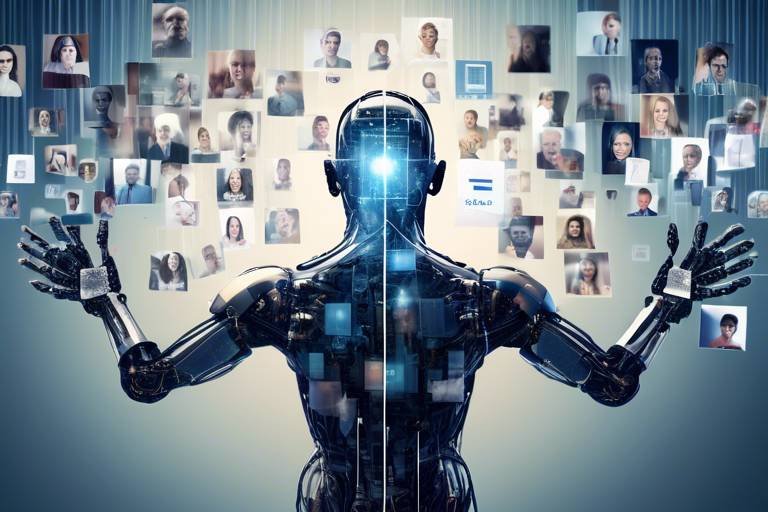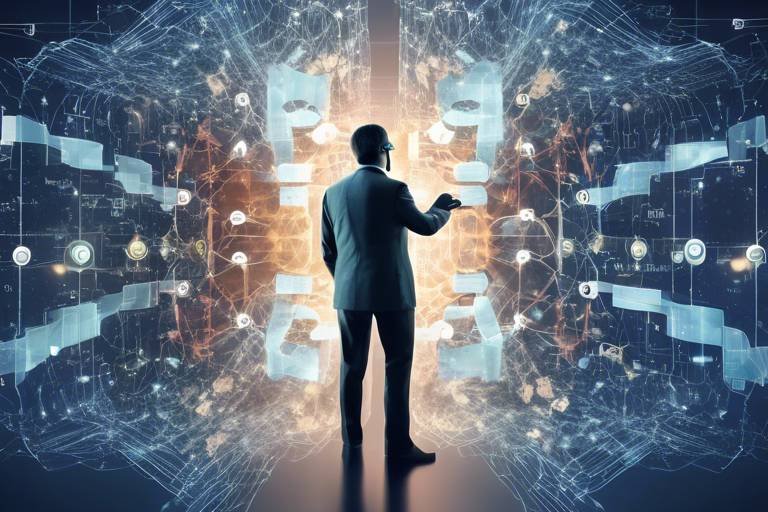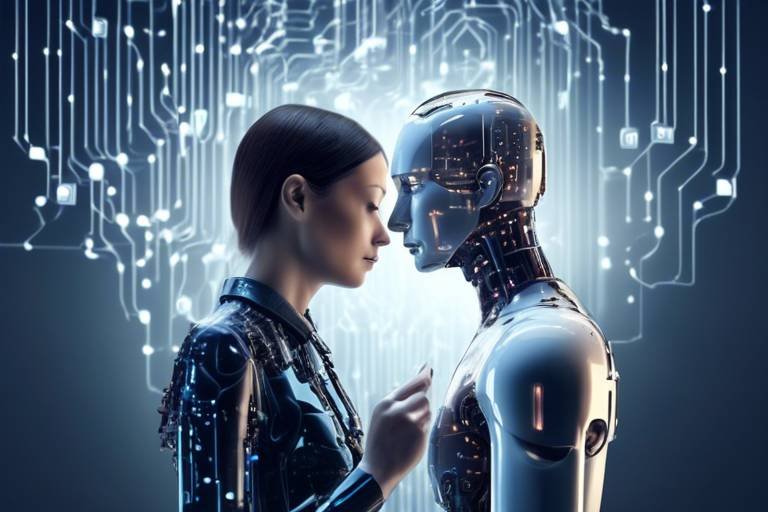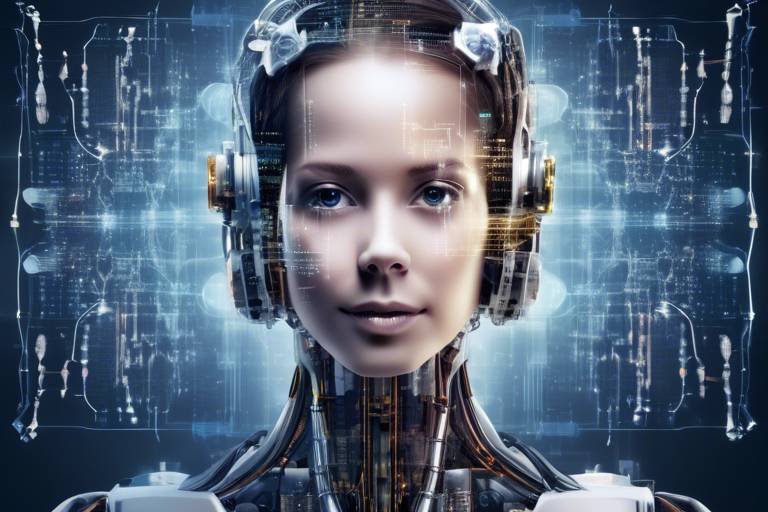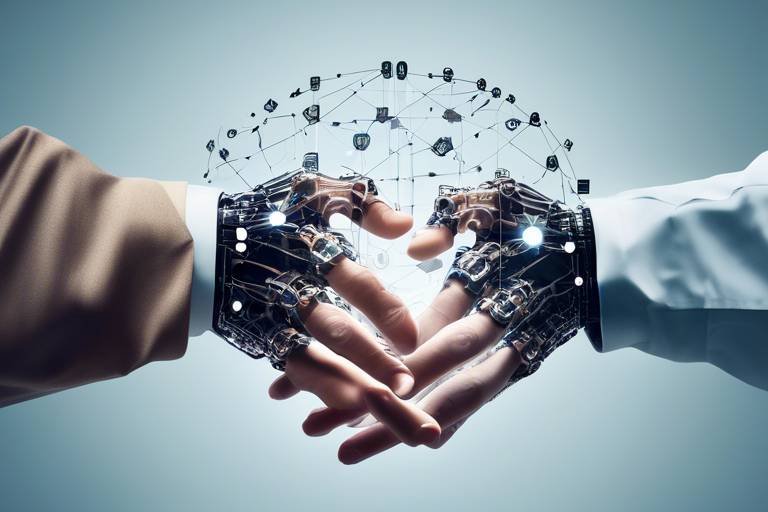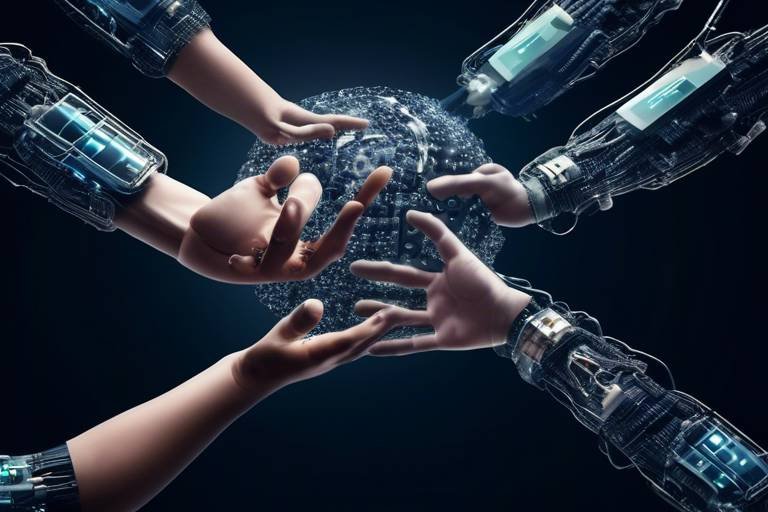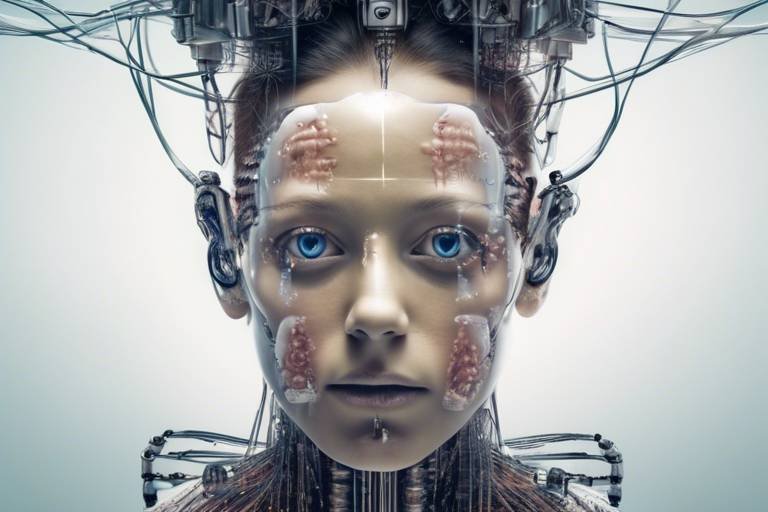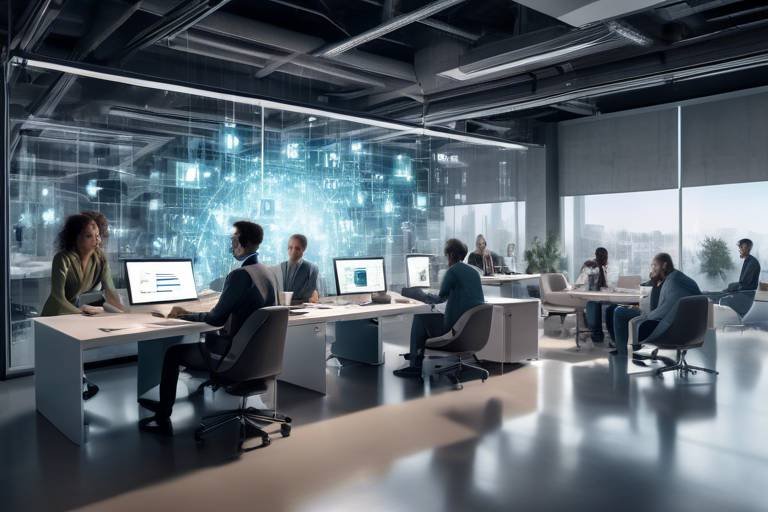Harnessing AI for Human Collaboration: Prospects and Challenges
In today's rapidly evolving world, the intersection of technology and human interaction has never been more critical. As we delve into the realm of artificial intelligence (AI), we find ourselves at the forefront of a transformative journey that promises to reshape how we collaborate. Imagine a workspace where AI tools not only enhance productivity but also foster a more inclusive and engaging environment for all team members. This article explores the integration of AI in enhancing human collaboration, highlighting both the benefits and the challenges that arise in this evolving landscape. So, what does the future hold for AI and teamwork? Let's dive in!
AI can significantly improve team dynamics by providing insights, facilitating communication, and optimizing workflows. Picture a scenario where your team is working on a project, and instead of sifting through endless emails, AI tools can summarize discussions, highlight key points, and even remind you of deadlines. Understanding these contributions can help organizations leverage AI for better collaboration. The potential for AI to act as a supportive partner in our daily tasks is enormous, but it requires a shift in mindset and approach.
AI-driven collaboration tools offer various advantages, such as increased efficiency, enhanced decision-making, and improved resource management. These tools can transform how teams interact and achieve their goals. For instance, consider how AI can analyze data trends and suggest actionable strategies, allowing teams to focus on creative problem-solving rather than getting bogged down in data analysis. This not only speeds up the decision-making process but also empowers team members to contribute their unique perspectives.
Communication is the lifeblood of any successful team, and AI technologies can streamline this process in remarkable ways. By automating responses, summarizing discussions, and providing real-time translation, AI fosters a more inclusive and effective collaborative environment. Imagine a team with members from different parts of the world, where language barriers could hinder progress. With AI-powered translation tools, everyone can engage in discussions seamlessly, breaking down traditional barriers that often stifle creativity.
Chatbots powered by AI can assist employees by answering queries and providing information, allowing teams to focus on more complex tasks and enhancing overall productivity. These digital assistants can handle routine inquiries, freeing up valuable time for team members to engage in strategic thinking and innovation. In a way, they serve as the unsung heroes of the workplace, tirelessly working behind the scenes to keep operations running smoothly.
Platforms that utilize AI can offer real-time collaboration features, enabling teams to work together seamlessly, regardless of geographic location. This capability is akin to having a virtual office where everyone can brainstorm ideas and share insights instantly. By breaking down traditional barriers, AI promotes a culture of collaboration that transcends physical boundaries, fostering a sense of unity among team members.
AI can analyze vast amounts of data, providing teams with actionable insights that lead to more informed decisions. This capability is especially crucial in today's fast-paced environment, where the ability to pivot quickly can make or break a project. By leveraging AI, teams can not only improve project outcomes but also drive innovation, as they are equipped with the knowledge to make strategic choices that align with their goals.
Despite its benefits, integrating AI into collaboration poses challenges that organizations must navigate carefully. These challenges include resistance to change, data privacy concerns, and the potential for bias in AI algorithms that can affect teamwork. It's essential to recognize that while AI can enhance collaboration, it also requires a thoughtful approach to ensure that all team members feel valued and included.
Organizations may face pushback from employees hesitant to adopt AI technologies. This resistance often stems from fear of the unknown or concerns about job security. Understanding these concerns and providing adequate training can facilitate smoother transitions and greater acceptance. By fostering an environment where employees feel empowered to embrace AI, organizations can unlock the full potential of these technologies.
The use of AI in collaboration raises important questions about data privacy and ethics. Organizations must navigate these issues to build trust and ensure compliance with regulations. It's crucial to establish clear guidelines on data usage and protection, ensuring that all team members are aware of their rights and responsibilities. This transparency will help foster a culture of trust, allowing AI to be seen as a valuable ally rather than a threat.
Looking ahead, the synergy between AI and human collaboration is likely to evolve, presenting new opportunities and challenges that will shape the future of work and teamwork. As we continue to explore the capabilities of AI, it's essential to remain vigilant and proactive in addressing the challenges that arise. By doing so, we can create a collaborative landscape that harnesses the power of AI while prioritizing the human element that makes teamwork truly effective.
- What is AI-driven collaboration? AI-driven collaboration refers to the use of artificial intelligence technologies to enhance teamwork, streamline communication, and improve decision-making processes.
- How can AI improve team communication? AI can improve team communication by automating responses, summarizing discussions, and providing real-time translation, making interactions more efficient and inclusive.
- What challenges might organizations face when integrating AI? Organizations may face challenges such as resistance to change, data privacy concerns, and potential biases in AI algorithms that could affect collaboration.
- What is the future of AI in teamwork? The future of AI in teamwork is likely to involve greater integration and collaboration, presenting new opportunities for innovation while also necessitating careful consideration of ethical and privacy issues.

The Role of AI in Team Dynamics
In today's fast-paced work environment, the integration of artificial intelligence (AI) is revolutionizing how teams operate and collaborate. Imagine a bustling office where every team member is equipped with a personal assistant that not only understands their tasks but also predicts their needs. This is the power of AI in enhancing team dynamics. By providing real-time insights and facilitating seamless communication, AI is transforming the traditional workplace into a more cohesive and efficient unit.
One of the most significant contributions of AI to team dynamics is its ability to analyze data and provide actionable insights. For instance, AI can sift through mountains of project data to identify patterns and trends that might go unnoticed by human eyes. This capability not only aids in decision-making but also helps teams align their goals more effectively. When everyone is on the same page, collaboration flourishes, leading to improved outcomes and greater job satisfaction among team members.
Furthermore, AI tools can facilitate communication in ways that were previously unimaginable. With features like automated responses and real-time translation, language barriers and miscommunication can be drastically reduced. This inclusivity fosters a collaborative environment where every voice is heard, regardless of geographical or linguistic differences. Imagine a team spread across the globe, yet working together as if they were in the same room—this is the reality that AI is helping to create.
Additionally, AI can optimize workflows by automating routine tasks, allowing team members to focus on what truly matters: creativity and strategy. For example, instead of spending hours on scheduling meetings or managing emails, AI can handle these mundane tasks, freeing up valuable time for employees to engage in more meaningful collaboration. This shift not only boosts productivity but also enhances team morale, as employees feel more empowered to contribute to innovative projects.
To illustrate the impact of AI on team dynamics, consider the following table that outlines key contributions:
| AI Contribution | Description |
|---|---|
| Data Analysis | AI analyzes large datasets to uncover insights that inform team decisions. |
| Enhanced Communication | AI tools facilitate real-time communication and overcome language barriers. |
| Workflow Optimization | Automation of routine tasks allows teams to focus on strategic initiatives. |
In summary, the role of AI in team dynamics is multifaceted and transformative. By enhancing communication, optimizing workflows, and providing valuable insights, AI is not just a tool but a catalyst for improved collaboration. As organizations continue to embrace these technologies, the potential for increased efficiency and innovation is boundless. So, are you ready to harness the power of AI to elevate your team's collaboration to new heights?

Benefits of AI-Driven Collaboration Tools
In today's fast-paced work environment, AI-driven collaboration tools have emerged as game-changers, revolutionizing how teams interact and achieve their objectives. These tools are not just about automating tasks; they are about enhancing the entire collaborative experience. Imagine walking into a workspace where every team member is on the same page, communication flows effortlessly, and decision-making is backed by data-driven insights. Sounds like a dream, right? Well, with AI, this dream is becoming a reality.
One of the primary benefits of AI-driven collaboration tools is their ability to increase efficiency. By automating mundane tasks such as scheduling meetings, sending reminders, and tracking project progress, teams can redirect their energy towards more strategic activities. For instance, tools like AI-powered project management software can automatically update stakeholders on project milestones, eliminating the need for tedious status meetings. This not only saves time but also enhances productivity across the board.
Moreover, these tools significantly enhance decision-making processes. AI can analyze vast amounts of data in real-time, providing teams with actionable insights that lead to informed decisions. Picture a scenario where a marketing team is trying to decide which campaign to launch next. With AI, they can access predictive analytics that highlight the potential success of various strategies based on historical data and market trends. This capability transforms decision-making from a gut feeling into a data-backed strategy.
Additionally, AI-driven collaboration tools foster improved resource management. By analyzing team workloads and project timelines, AI can suggest optimal resource allocation, ensuring that no team member is overburdened while others are underutilized. This not only enhances morale but also leads to better project outcomes. For example, a software development team might use AI to identify which developers are available to take on new tasks, ensuring that projects stay on track without overwhelming anyone.
Another exciting aspect of these tools is their ability to enhance communication within teams. AI can streamline communication by automating responses to common queries, summarizing lengthy discussions, and even providing real-time translation for teams spread across different countries. This inclusivity means that everyone can contribute, regardless of language barriers, fostering a sense of belonging and teamwork.
To illustrate the impact of AI-driven collaboration tools, consider the following table that outlines some key benefits:
| Benefit | Description |
|---|---|
| Increased Efficiency | Automation of routine tasks allows teams to focus on strategic initiatives. |
| Enhanced Decision-Making | Real-time data analysis provides actionable insights for informed choices. |
| Improved Resource Management | Optimal allocation of team resources leads to better project outcomes. |
| Streamlined Communication | AI facilitates effective communication, breaking down language barriers. |
In summary, the integration of AI-driven collaboration tools is not merely a trend; it is an evolution in how teams work together. By harnessing the power of AI, organizations can unlock unprecedented levels of efficiency, decision-making prowess, and resource management. As we embrace these technologies, the future of teamwork looks not just promising, but thrilling.
- What are AI-driven collaboration tools? These are software applications that utilize artificial intelligence to enhance communication, streamline workflows, and improve decision-making within teams.
- How do AI tools improve team communication? AI tools can automate responses, summarize conversations, and provide real-time translations, making communication more efficient and inclusive.
- What challenges might arise from using AI in collaboration? Challenges include resistance to change, data privacy concerns, and potential biases in AI algorithms.
- Can AI replace human collaboration? No, AI is designed to enhance human collaboration, not replace it. The synergy between AI and human input leads to better outcomes.

Improving Communication with AI
In today’s fast-paced work environment, effective communication is the cornerstone of successful collaboration. Enter artificial intelligence, a game-changer that is revolutionizing how teams interact. Imagine a world where your emails are organized, your meetings are summarized, and language barriers are virtually nonexistent. Sounds appealing, right? AI technologies are making this a reality by streamlining communication in several impactful ways.
One of the most significant advantages of AI in communication is the automation of responses. With AI-powered tools, teams can set up automated replies for frequently asked questions, allowing employees to receive immediate assistance. This not only saves time but also ensures that no query goes unanswered. For instance, when a team member has a question about project deadlines, an AI system can quickly provide the necessary information, freeing up human resources for more complex tasks.
Additionally, AI can enhance the quality of discussions by summarizing conversations. In meetings, AI tools can take notes and highlight key points, ensuring that everyone is on the same page. This is particularly beneficial in large teams, where it’s easy for important details to get lost in the shuffle. By having a concise summary of discussions, team members can focus on action items rather than trying to remember every detail.
Moreover, AI can bridge the gap between different languages through real-time translation. This feature fosters a more inclusive environment, allowing teams from diverse backgrounds to collaborate seamlessly. Imagine a virtual meeting where participants speak various languages, yet everyone understands each other perfectly—this is the power of AI-driven translation tools.
To illustrate the impact of AI on communication, consider the following table that highlights some key AI communication tools and their features:
| AI Tool | Key Features | Benefits |
|---|---|---|
| AI Chatbots | 24/7 availability, automated responses | Increased efficiency, reduced response time |
| Meeting Summarizers | Automatic note-taking, key point extraction | Improved clarity, better follow-up |
| Translation Software | Real-time language translation | Enhanced inclusivity, better collaboration |
As we delve deeper into the integration of AI in our daily workflows, it’s essential to recognize that while these tools offer tremendous potential, they are not without their challenges. However, by embracing these innovations, organizations can create a more collaborative and efficient work environment. The future of communication is bright, and AI is leading the way.

AI Chatbots in the Workplace
Imagine walking into your office and instantly having a virtual assistant ready to tackle your questions and streamline your tasks. AI chatbots are transforming the workplace by acting as the first line of support for employees. These intelligent systems can handle a multitude of inquiries ranging from simple FAQs to complex problem-solving, allowing human workers to devote their energy to more creative and strategic endeavors.
One of the most remarkable aspects of AI chatbots is their ability to provide instantaneous responses. This not only enhances productivity but also minimizes the frustration that often accompanies waiting for help. For instance, rather than sifting through endless emails or searching through company manuals, employees can simply ask a chatbot for assistance. This leads to a more efficient workflow and a happier workforce.
In addition to answering questions, AI chatbots can also perform various administrative tasks. They can schedule meetings, send reminders, and even assist in onboarding new employees. By automating these routine processes, chatbots free up valuable time for teams to focus on what truly matters—innovation and collaboration. Here's how they can specifically enhance workplace efficiency:
- 24/7 Availability: Chatbots can operate around the clock, ensuring that employees always have access to information and support, regardless of time zones.
- Data Handling: They can manage and analyze employee inquiries, providing insights into common questions that may indicate areas for improvement within the organization.
- Cost-Effective Solution: By reducing the need for extensive support staff, chatbots can significantly lower operational costs while maintaining high levels of service.
However, it's essential to consider that while AI chatbots are incredibly useful, they are not without limitations. For example, they may struggle with understanding nuanced human emotions or complex queries that require empathy. This is where the human touch remains irreplaceable. Therefore, the best approach is to use chatbots as a complement to human expertise, creating a hybrid model that maximizes the strengths of both.
In conclusion, AI chatbots are not just a technological fad; they are a vital component of the modern workplace. By enhancing communication, streamlining processes, and allowing employees to focus on higher-level tasks, chatbots are paving the way for a more productive and satisfying work environment. As we continue to embrace this technology, the potential for improved collaboration and efficiency seems limitless.
Q: What are AI chatbots?
A: AI chatbots are software applications that use artificial intelligence to simulate human conversation and assist users with various tasks and inquiries.
Q: How can AI chatbots improve workplace efficiency?
A: By providing instant responses to employee inquiries, automating administrative tasks, and being available 24/7, chatbots help streamline processes and free up time for more critical work.
Q: Are there any limitations to using AI chatbots?
A: Yes, while they are effective for many tasks, chatbots may struggle with complex queries that require emotional understanding or nuanced responses, making human intervention necessary in those cases.
Q: How do I ensure my team accepts AI chatbots?
A: Providing comprehensive training and highlighting the benefits of using chatbots can help ease the transition and encourage acceptance among team members.

Real-Time Collaboration Platforms
In today's fast-paced work environment, have emerged as essential tools for teams striving to enhance productivity and connectivity. These platforms enable team members to work together seamlessly, irrespective of their physical locations. Imagine a world where a project manager in New York can brainstorm ideas in real-time with a developer in Tokyo, all while ensuring that everyone is on the same page. This is not just a dream; it's the reality offered by modern collaboration tools.
One of the standout features of these platforms is their ability to provide a shared workspace where team members can contribute simultaneously. This means that whether you're drafting a document, creating a presentation, or coding a new feature, everyone involved can see changes as they happen. This instant feedback loop not only speeds up the workflow but also fosters a sense of teamwork and unity among members. The engagement level skyrockets when everyone can contribute in real-time, leading to more dynamic discussions and innovative solutions.
Moreover, many real-time collaboration platforms come equipped with advanced AI capabilities that further enhance their functionality. For instance, AI can assist in automating mundane tasks, such as scheduling meetings or tracking project deadlines. By taking care of these repetitive chores, team members can devote more time to creative problem-solving and strategic planning. This shift not only boosts efficiency but also contributes to higher job satisfaction, as employees can focus on what truly matters.
Additionally, these platforms often incorporate features that enhance communication, such as video conferencing, chat functions, and file sharing. With the ability to connect through various mediums, teams can choose the best way to collaborate depending on the nature of their tasks. For example, a quick chat may suffice for simple queries, while a video call might be necessary for more complex discussions. This flexibility ensures that communication flows effortlessly, making it easier for teams to stay aligned and informed.
However, while the benefits are substantial, it's essential to choose the right platform that aligns with your team's specific needs. Factors such as user interface, integration capabilities with other tools, and security features should be considered. Below is a comparison of some popular real-time collaboration platforms:
| Platform | Key Features | Best For |
|---|---|---|
| Slack | Messaging, file sharing, integrations | Small to medium teams |
| Microsoft Teams | Video calls, document collaboration, task management | Enterprise-level organizations |
| Zoom | Video conferencing, webinars, screen sharing | Remote meetings and presentations |
| Trello | Task boards, project tracking, collaboration | Project management |
In conclusion, the rise of real-time collaboration platforms has revolutionized the way teams operate. By breaking down geographical barriers and enhancing communication, these tools are not just improving workflows; they are reshaping how we think about teamwork. As organizations continue to embrace these technologies, the potential for innovation and creativity will only grow, leading to a more connected and productive workforce.
- What are real-time collaboration platforms?
These are tools that allow team members to work together simultaneously, regardless of their location. - How do AI features enhance collaboration?
AI can automate repetitive tasks, provide insights, and improve communication, allowing teams to focus on more critical aspects of their work. - What should I consider when choosing a collaboration platform?
Look for features such as user interface, integration capabilities, security, and specific functionalities that meet your team's needs. - Are real-time collaboration platforms secure?
Most reputable platforms prioritize security, but it's essential to review their security measures and compliance with regulations.

Enhancing Decision-Making Processes
In today’s fast-paced business environment, making informed decisions is more critical than ever. Enter artificial intelligence—a game changer that can revolutionize the way teams approach decision-making. Imagine having a powerful assistant that sifts through mountains of data, identifies trends, and provides actionable insights at lightning speed. Sounds like a dream, right? Well, with AI, this dream is becoming a reality.
AI can analyze vast amounts of data from various sources, transforming raw information into valuable insights. This capability allows teams to make decisions based on data-driven evidence rather than gut feelings or assumptions. For example, AI algorithms can evaluate past project performances, market trends, and customer feedback to help teams predict outcomes more accurately. This not only improves the quality of decisions but also boosts the confidence of team members when they stand behind their choices.
To illustrate the impact of AI on decision-making, consider the following table that outlines the key advantages:
| Advantage | Description |
|---|---|
| Data Analysis | AI can process and analyze large datasets quickly, uncovering insights that would take humans much longer to find. |
| Predictive Analytics | By identifying patterns in historical data, AI can forecast future trends, aiding in strategic planning. |
| Risk Assessment | AI tools can evaluate potential risks associated with decisions, allowing teams to make more informed choices. |
| Increased Speed | AI accelerates the decision-making process, enabling teams to respond to challenges and opportunities swiftly. |
Additionally, AI can facilitate collaboration among team members during the decision-making process. By providing real-time data and insights, it ensures that everyone is on the same page. Imagine a scenario where team members are scattered across different locations, yet they can access the same up-to-the-minute data and analytics. This level of transparency not only enhances communication but also fosters a collaborative spirit, as everyone can contribute to discussions with the same foundational knowledge.
However, it’s essential to remember that while AI can significantly enhance decision-making, it should not replace human judgment. The best outcomes arise when teams leverage AI as a tool to complement their expertise. After all, AI lacks the emotional intelligence and contextual understanding that humans bring to the table. Therefore, the future of decision-making lies in the harmonious integration of AI capabilities and human insight.
- How does AI improve decision-making? AI enhances decision-making by providing data-driven insights, predictive analytics, and risk assessments, allowing teams to make informed choices quickly.
- Can AI completely replace human decision-making? No, AI should be viewed as a tool to assist in decision-making, complementing human judgment rather than replacing it.
- What industries benefit the most from AI-driven decision-making? Industries such as finance, healthcare, and marketing have seen significant improvements in decision-making processes due to AI integration.

Challenges of Integrating AI in Collaboration
Integrating artificial intelligence into collaborative environments is not without its hurdles. While the potential benefits are enticing, the path to successful implementation can be fraught with challenges that organizations must navigate carefully. One significant barrier is the resistance to change from employees who may feel threatened by AI technologies. This resistance often stems from a fear of job displacement or a lack of understanding of how AI can enhance their roles rather than replace them. To address this, organizations need to foster a culture of openness and provide comprehensive training that demystifies AI, illustrating its potential as a supportive tool in the workplace.
Another pressing issue is data privacy and ethical considerations. As teams increasingly rely on AI-driven tools to facilitate collaboration, the volume of sensitive data being processed raises important questions about security and compliance. Organizations must ensure that they are adhering to data protection regulations while also being transparent with employees about how their data is being used. This transparency is crucial for building trust among team members, as they need to feel confident that their information is handled responsibly.
Moreover, the potential for bias in AI algorithms presents a significant challenge to effective collaboration. If AI systems are not designed and trained with a diverse dataset, they can inadvertently perpetuate existing biases, affecting decision-making processes and team dynamics. For example, an AI tool that analyzes employee performance might favor certain demographics over others, leading to inequitable outcomes. To mitigate this risk, organizations must prioritize inclusivity in their AI development processes and regularly audit their algorithms for fairness.
In summary, while the integration of AI into collaborative efforts offers numerous advantages, it also poses several challenges that cannot be overlooked. Addressing resistance to change, ensuring data privacy, and mitigating bias in AI systems are all critical steps that organizations must take to harness the full potential of AI in enhancing human collaboration.
- What are the main challenges of integrating AI in collaboration?
Resistance to change, data privacy concerns, and bias in AI algorithms are the primary challenges organizations face. - How can organizations address employee resistance to AI?
Providing training and fostering a culture of openness can help alleviate fears and encourage acceptance. - Why is data privacy important in AI integration?
Data privacy ensures that sensitive information is protected, building trust among employees and complying with regulations. - What can be done to prevent bias in AI algorithms?
Organizations should prioritize diversity in data sets and regularly audit their AI systems to ensure equitable outcomes.

Addressing Resistance to Change
Integrating AI into workplace collaboration can often feel like navigating a stormy sea. Many employees may feel apprehensive about adopting new technologies, fearing that they could disrupt established workflows or even threaten their job security. This resistance to change can stem from a variety of factors, including a lack of understanding, fear of the unknown, and concerns about job displacement. To address these issues effectively, organizations must take a proactive approach that fosters an environment of trust and openness.
One of the first steps in overcoming resistance is to engage employees in the conversation. Rather than imposing AI tools from the top down, organizations should invite feedback and input from team members. This collaborative approach not only helps to demystify AI technologies but also empowers employees to feel like they are part of the change rather than victims of it. For example, holding workshops or informational sessions can provide employees with the knowledge they need to understand how AI can complement their roles, rather than replace them.
Moreover, providing adequate training is crucial. When employees are equipped with the skills to use AI tools effectively, they are more likely to embrace the change. Training sessions should be interactive and tailored to the specific needs of different teams. Consider implementing a mentorship program where tech-savvy employees can assist their colleagues in navigating new tools. This not only enhances learning but also builds camaraderie within the team.
Organizations should also emphasize the benefits of AI in collaboration. By highlighting success stories and showcasing how AI has led to improved efficiency and productivity in other teams or companies, employees can see the tangible advantages of adopting these technologies. For instance, sharing case studies that illustrate how AI has streamlined communication or enhanced project outcomes can help to shift perceptions.
Lastly, it’s essential to create a culture that embraces innovation and change. This means recognizing that while some employees may resist new technologies, others will thrive on them. Encouraging a mindset of continuous improvement can help to alleviate fears and promote a more adaptable workforce. By celebrating small wins and acknowledging the contributions of those who are willing to embrace AI, organizations can cultivate a more positive attitude towards change.
In conclusion, addressing resistance to change when integrating AI into collaboration requires a multifaceted approach. By fostering open communication, providing thorough training, showcasing benefits, and promoting an innovative culture, organizations can ease the transition and enable their teams to harness the full potential of AI. After all, the journey of a thousand miles begins with a single step, and in this case, that step is towards a collaborative future enriched by AI.
- What are the main reasons employees resist AI integration? Resistance often stems from fear of job loss, lack of understanding, and discomfort with new technologies.
- How can organizations effectively train employees on new AI tools? Organizations can conduct interactive workshops, offer mentorship programs, and provide ongoing support to help employees feel confident in using AI.
- What benefits can AI bring to team collaboration? AI can streamline communication, enhance decision-making, and improve overall efficiency, leading to better project outcomes.
- How can leaders encourage a culture that embraces change? By celebrating successes, recognizing contributions, and promoting a mindset of continuous improvement, leaders can foster a more adaptable workforce.

Data Privacy and Ethical Considerations
As organizations increasingly integrate AI into their collaborative frameworks, the conversation surrounding data privacy and ethical considerations has never been more critical. With AI systems analyzing vast amounts of data, including sensitive information, the potential for misuse or unauthorized access raises serious concerns. Imagine a scenario where an AI tool inadvertently exposes confidential project details or personal employee data—this is a nightmare that every organization must strive to avoid.
To navigate these challenges, companies need to implement robust data protection measures. This can include encryption, access controls, and regular audits of AI systems to ensure compliance with data protection regulations like the General Data Protection Regulation (GDPR). These regulations not only mandate the protection of personal data but also require organizations to be transparent about how they collect and use this information. In a world where trust is paramount, being upfront about data usage can significantly enhance employee and client confidence.
Moreover, ethical considerations extend beyond mere compliance. Organizations should strive to create an environment where AI is used responsibly. This means actively working to eliminate bias in AI algorithms, which can lead to unfair treatment of individuals based on race, gender, or other factors. For instance, if an AI tool is used to evaluate employee performance and it inadvertently favors certain demographics over others, it could create a toxic workplace culture and lead to legal ramifications. Thus, it is essential to regularly assess AI systems for bias and make necessary adjustments.
To better understand the implications of AI on data privacy and ethics, consider the following table that outlines key considerations:
| Consideration | Description | Best Practices |
|---|---|---|
| Data Protection | Ensuring that sensitive data is secured against unauthorized access. | Implement encryption and access controls. |
| Transparency | Being clear about how data is collected and used. | Regularly communicate data practices to stakeholders. |
| Bias Mitigation | Reducing the risk of biased outcomes from AI algorithms. | Conduct regular bias audits and adjust algorithms accordingly. |
In conclusion, while the integration of AI into collaborative environments presents numerous advantages, it also necessitates a careful approach to data privacy and ethics. Organizations must be proactive in addressing these issues to foster a culture of trust and responsibility. By prioritizing data protection and ethical use of AI, companies can not only enhance collaboration but also pave the way for a more equitable workplace.
- What are the main data privacy concerns with AI?
The main concerns include unauthorized access to sensitive information, misuse of data, and compliance with regulations. - How can organizations ensure ethical AI use?
Organizations can ensure ethical use by regularly auditing AI systems for bias, providing transparency about data usage, and implementing strong data protection measures. - What regulations should companies be aware of?
Companies should be aware of regulations like GDPR, which governs data protection and privacy in the European Union.

The Future of AI and Human Collaboration
The future of AI and human collaboration is not just a fleeting trend; it is an evolving landscape that promises to redefine how we work together. As technology advances, we find ourselves at the cusp of a revolution that blends human creativity with the computational power of AI. Imagine a world where mundane tasks are handled seamlessly by machines, allowing humans to focus on what they do best—innovating and creating. The synergy between AI and human collaboration will likely lead to groundbreaking advancements in various fields, from healthcare to education, making our collective efforts more effective and impactful.
One of the most exciting prospects is the development of intelligent systems that can adapt to the needs of teams. These systems will not only facilitate communication but also learn from interactions to improve over time. Think of it as having a personal assistant who knows your preferences, understands your workflow, and can anticipate your needs before you even voice them. This kind of collaboration will enhance productivity, reduce friction in teamwork, and foster a culture of innovation.
However, with great potential comes great responsibility. As we embrace this future, we must also tackle the challenges that arise. Issues such as data privacy, ethical considerations, and the potential for algorithmic bias need to be addressed proactively. Organizations will need to establish frameworks that not only comply with regulations but also prioritize the ethical implications of their AI applications. This is crucial for building trust among team members and ensuring that AI serves as a tool for empowerment rather than a source of anxiety.
Moreover, the integration of AI into human collaboration will necessitate a shift in organizational culture. Companies will need to cultivate an environment where employees feel comfortable embracing new technologies. Training programs that emphasize the benefits of AI, alongside hands-on experience, will be vital in reducing resistance to change. By fostering a culture of continuous learning, organizations can ensure that their teams are not just consumers of technology but active participants in shaping its evolution.
As we look to the horizon, it’s clear that the collaboration between AI and humans will continue to grow. The potential applications are vast and varied. From enhancing customer service through AI-driven chatbots to utilizing machine learning for predictive analytics in project management, the possibilities are endless. In fact, a recent survey indicated that 75% of organizations plan to invest in AI tools to improve team collaboration over the next five years.
| Year | % of Organizations Investing in AI |
|---|---|
| 2023 | 45% |
| 2024 | 60% |
| 2025 | 75% |
Ultimately, the future of AI and human collaboration hinges on our ability to adapt and innovate. As we harness the power of AI, we must also remain vigilant in ensuring that our human values are preserved. By striking a balance between technological advancement and ethical responsibility, we can create a future where AI enhances our collaborative efforts, driving us toward a more productive and innovative world.
- What is the role of AI in enhancing team collaboration? AI enhances team collaboration by streamlining communication, automating tasks, and providing actionable insights from data analysis.
- How can organizations address resistance to AI adoption? Organizations can address resistance by providing training, demonstrating the benefits of AI, and fostering an open culture that encourages feedback.
- What ethical considerations should be taken into account? Organizations must consider data privacy, algorithmic bias, and the overall impact of AI on employee roles and responsibilities.
Frequently Asked Questions
- What are the main benefits of using AI in team collaboration?
AI enhances team collaboration by boosting efficiency, improving decision-making, and optimizing resource management. It allows teams to communicate more effectively and work together seamlessly, regardless of location.
- How does AI improve communication within teams?
AI streamlines communication through automation of responses, summarizing discussions, and offering real-time translation services. This fosters a more inclusive environment, making it easier for team members to engage and share ideas.
- What role do AI chatbots play in the workplace?
AI chatbots assist employees by answering queries and providing information quickly. This allows team members to focus on more complex tasks, thereby enhancing overall productivity and efficiency in the workplace.
- What challenges might organizations face when integrating AI?
Organizations may encounter resistance to change from employees, concerns regarding data privacy, and potential biases in AI algorithms. Addressing these challenges requires transparency, training, and a commitment to ethical practices.
- How can organizations overcome resistance to AI adoption?
To overcome resistance, organizations should engage employees in the process, provide comprehensive training, and clearly communicate the benefits of AI technologies. This can help ease fears and encourage acceptance.
- What ethical considerations should be taken into account when using AI?
Organizations must navigate data privacy issues and ensure compliance with regulations. Building trust with employees and stakeholders is crucial, as is addressing potential biases in AI systems to ensure fair collaboration.
- What does the future hold for AI and human collaboration?
The future of AI and human collaboration is likely to evolve, presenting both new opportunities and challenges. As technology advances, organizations will need to adapt and find ways to leverage AI for enhanced teamwork and innovation.

